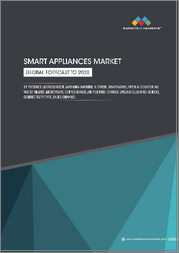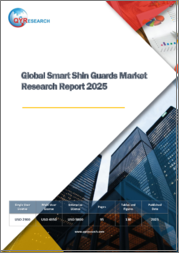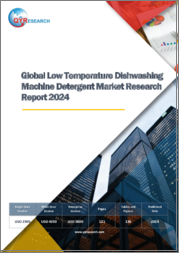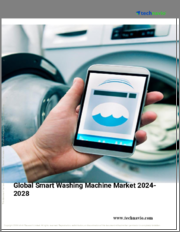
|
시장보고서
상품코드
1623373
세계의 세탁 가전 시장 규모 : 제품 유형별, 기술별, 최종사용자별, 지역별, 범위 및 예측Global Washing Appliances Market Size By Product Type, By Technology, By End-User, By Geographic Scope And Forecast |
||||||
세탁 가전 시장 규모와 예측
세탁 가전 시장 규모는 최근 수년간 대폭적인 성장률로 급성장하고 있으며, 시장 추산·예측에서는 2024-2031년 크게 성장할 것으로 예측됩니다.
세계의 세탁 가전 시장 성장 촉진요인
세탁기 시장 시장 성장 촉진요인은 다양한 요인에 의해 영향을 받을 수 있습니다.
인구 증가 :
인구 증가: 세계 인구가 증가함에 따라 세탁기에 대한 수요도 증가합니다. 특히 도시화와 가처분 소득 증가로 인해 가구 형성이 촉진되는 신흥 국가에서 특히 두드러집니다.
기술의 진보 :
에너지 효율이 높은 모델, 사물인터넷(IoT) 기능을 갖춘 지능형 세탁기, 스팀 세척, 고속 세척 등의 기능은 소비자의 호기심을 자극하고 산업을 발전시킬 것입니다.
라이프스타일의 변화:
시간 절약 및 자동화 기능을 갖춘 세탁기에 대한 수요는 바쁜 라이프스타일, 맞벌이 가정, 편의성에 대한 선호에 의해 주도되고 있습니다.
환경에 대한 관심 :
소비자들의 환경보호에 대한 인식이 높아지면서 물과 에너지 사용량이 적은 세탁기에 대한 수요가 증가함에 따라 각 제조업체들은 보다 환경 친화적인 모델을 개발하기 위해 노력하고 있습니다.
도시화 :
도시화 추세(특히 신흥 지역)로 인해 아파트나 좁은 주거 공간으로 이사하는 사람들이 늘어나면서 야외에서 건조할 수 있는 선택지가 줄어들면서 세탁기에 대한 수요가 증가하고 있습니다.
구매 주기:
교체 주기:세탁기 교체 주기는 시장 성장 촉진요인 중 하나입니다. 교체 주기는 제품의 내구성, 기술 노후화, 소비자 선호도 변화 등 여러 가지 요인에 의해 영향을 받습니다.
소득 수준 :
가처분소득 증가로 소비자들은 최첨단 기능을 갖춘 고가의 세탁기를 구매할 수 있게 되었고, 특히 신흥 경제국에서 시장 확대가 가속화되고 있습니다.
정부 규제:
전 세계 각국 정부는 엄격한 에너지 효율 기준과 규제를 도입하고 있으며, 이는 제조업체에 에너지 효율이 높은 세탁기를 생산할 수 있는 인센티브를 제공하고 소비자의 선택과 제품 개발에 영향을 미치고 있습니다.
COVID-19 팬데믹:
대유행(팬데믹) : 팬데믹으로 인해 위생에 대한 인식이 높아지면서 사람들이 가정내 청결 및 위생을 우선시하므로 가전제품 세탁기에 대한 수요가 증가하고 있습니다.
교체 요구 사항:
기술의 발전과 함께 소비자들은 마모, 고장 등의 이유로 낡은 세탁기를 신형 세탁기로 교체하고 있으며, 이는 시장 확대의 원동력이 되고 있습니다.
세계 세탁 가전 시장 성장 억제요인
세탁기 시장에는 몇 가지 요인이 억제요인으로 작용할 수 있습니다. 이
기술의 변화 :
기술이 빠르게 발전함에 따라 일부 제품은 구식이 될 수 있습니다. 소비자는 더 새롭고 더 정교한 모델이 곧 출시 될 것이라고 생각하면 세탁기 구매를 기다릴 수 있습니다.
규제상의 제약:
안전 및 에너지 효율과 관련된 정부 규정이 변경되면 제조 비용이 상승하여 제품 가용성 및 비용에 영향을 미칠 수 있습니다.
환경문제에 대한 우려:
환경 문제에 대한 인식이 높아짐에 따라 물과 에너지 효율이 높은 세탁기 등 보다 친환경적인 세탁기를 대체할 수 있는 대안이 요구될 수 있습니다.
공급망 혼란:
자연 재해, 무역 분쟁, 전염병 등은 부품 및 원자재 부족으로 인해 세탁기 제조 및 유통에 영향을 미칠 수 있는 공급망 혼란의 예입니다.
고객의 선호도 :
세탁 가전제품에 대한 시장 수요는 소비자의 선호도 변화, 예를 들어 세탁기를 직접 구매하기보다는 임대나 렌탈로 전환하는 움직임에 영향을 받을 수 있습니다.
주택시장 동향 :
세탁 가전은 주택 구입이나 임대와 동시에 구입하는 경우가 많기 때문에 신규 주택의 감소, 임대주택 증가 등 주택시장의 변화가 세탁기 수요에 영향을 미칠 수 있습니다.
목차
제1장 서론
- 시장 정의
- 시장 세분화
- 조사 방법
제2장 개요
- 주요 조사 결과
- 시장 개요
- 시장 하이라이트
제3장 시장 개요
- 시장 규모와 성장 가능성
- 시장 동향
- 시장 성장 촉진요인
- 시장 성장 억제요인
- 시장 기회
- Porter's Five Forces 분석
제4장 세탁 가전 시장 : 제품 유형별
- 세탁기
- 세탁 건조기
- 기타
제5장 세탁 가전 시장 : 기술별
- 기존형
- 스마트/커넥티드
- 에너지 효율
제6장 세탁 가전 시장 : 최종사용자별
- 주택용
- 상업용
제7장 지역별 분석
- 북미
- 미국
- 캐나다
- 멕시코
- 유럽
- 영국
- 독일
- 프랑스
- 이탈리아
- 아시아태평양
- 중국
- 일본
- 인도
- 호주
- 라틴아메리카
- 브라질
- 아르헨티나
- 칠레
- 중동 및 아프리카
- 남아프리카공화국
- 사우디아라비아
- 아랍에미리트
제8장 시장 역학
- 시장 성장 촉진요인
- 시장 성장 억제요인
- 시장 기회
- 시장에 대한 COVID-19의 영향
제9장 경쟁 구도
- 주요 기업
- 시장 점유율 분석
제10장 기업 개요
- Midea Group Co., Ltd.
- Videocon Industries Limited
- Whirlpool Corporation
- Arcelik A.S.
제11장 시장 전망과 기회
- 신규 기술
- 향후 시장 동향
- 투자 기회
제12장 부록
- 약어 리스트
- 전시와 참고 문헌
Washing Appliances Market Size And Forecast
Washing Appliances Market size is growing at a faster pace with substantial growth rates over the last few years and is estimated that the market will grow significantly in the forecasted period i.e., 2024 to 2031.
Global Washing Appliances Market Drivers
The market drivers for the Washing Appliances Market can be influenced by various factors. These may include:
Population Growth:
As the world's population rises, so does the need for washing machines, particularly in emerging nations where household formation is fueled by urbanization and increased disposable incomes.
Technological Advancements:
Models that are energy-efficient, intelligent washing machines with Internet of Things (IoT) capabilities, and features like steam cleaning and rapid wash pique consumers' curiosity and propel the industry.
Changing Lifestyles:
The demand for washing machines with time-saving features and automation is being driven by busy lifestyles, dual-income homes, and a preference for convenience.
Environmental Concerns:
As consumers become more conscious of environmental sustainability, they are looking for washing machines that use less water and energy, which is driving manufacturers to create more environmentally friendly models.
Urbanization:
As more people move into flats and smaller living spaces with fewer alternatives for outside drying, the trend of urbanization-particularly in emerging regions-is driving up demand for washing machines.
Replacement Cycles:
The washing machine replacement cycle is a major driver of market dynamics. It is impacted by a number of factors, including product durability, technical obsolescence, and shifting consumer preferences.
Income Levels:
Growing disposable incomes allow consumers to purchase more expensive washing machines with cutting-edge features, which fuels market expansion, especially in emerging economies.
Government Regulations:
Governments all over the world have implemented strict energy efficiency standards and regulations, which incentivize manufacturers to make energy-efficient washing appliances and influence consumer choices and product development.
COVID-19 Pandemic:
As people prioritize cleanliness and sanitization at home, the pandemic has raised awareness of hygiene, which is increasing demand for appliance washing.
Replacement Needs:
As technology advances, consumers replace their outdated washing machines with newer versions due to wear and tear, malfunctions, and other reasons, which fuels market expansion.
Global Washing Appliances Market Restraints
Several factors can act as restraints or challenges for the Washing Appliances Market. These may include:
Technological Changes:
As technology develops quickly, some goods may become outdated. If consumers believe that newer, more sophisticated models will be introduced soon, they might wait to buy washing machines.
Regulatory Constraints:
Modifications to government rules, such as those pertaining to safety or energy efficiency, may result in higher manufacturing costs and an impact on the availability and cost of products.
Environmental Concerns:
As people become more conscious of environmental issues, they might look for more environmentally friendly washing machine substitutes, including water- or energy-efficient ones.
Disruptions to the Supply Chain:
Natural catastrophes, trade disputes, or pandemics are examples of supply chain disruptions that can result in shortages of components or raw materials, which can affect the manufacture and distribution of washing machines.
Customer Preferences:
The market demand for washing appliances may be impacted by shifting consumer preferences, such as a move toward leasing or renting appliances rather than buying them completely.
Housing Market Trends:
As washing appliances are frequently bought in tandem with home purchases or rents, changes in the housing market, such as a decline in new home building or an increase in rental housing, can have an effect on demand for these goods.
Global Washing Appliances Market Segmentation Analysis
The Global Washing Appliances Market is Segmented on the basis of, Product Type, Technology, End-User and Geography.
Washing Appliances Market, By Product Type
- Washing Machines:
- This segment can further be divided into front-load, top-load, and semi-automatic washing machines.
- Washer-Dryers:
- Appliances that combine washing and drying functionalities in a single unit.
- Others:
- This may include niche products like portable washing machines or compact washers.
Washing Appliances Market, By Technology
- Traditional:
- Conventional washing machines with basic functionalities.
- Smart/Connected:
- Washing machines equipped with smart features such as Wi-Fi connectivity, smartphone integration, and advanced sensors for automation.
- Energy-efficient:
- Appliances designed to consume less energy and water, meeting environmental standards.
Washing Appliances Market, By End-User
- Residential:
- Washing appliances used in households for personal laundry needs.
- Commercial:
- Industrial-scale washing appliances used in laundromats, hotels, hospitals, and other commercial establishments.
Washing Appliances Market, By Geography
- North America:
- Market conditions and demand in the United States, Canada, and Mexico.
- Europe:
- Analysis of the Washing Appliances Market in European countries.
- Asia-Pacific:
- Focusing on countries like China, India, Japan, South Korea, and others.
- Middle East and Africa:
- Examining market dynamics in the Middle East and African regions.
- Latin America:
- Covering market trends and developments in countries across Latin America.
Key Players
- The major players in the Washing Appliances Market are:
- Midea Group Co., Ltd.
- Videocon Industries Limited
- Whirlpool Corporation
- Arcelik A.S.
- Whirlpool
- LG
- Electrolux
- IFB Industries
- Samsung
- GE
- Siemens
- Philips
- BSH Hausgerate
- MIRC Electronics
- Panasonic
- Haier
TABLE OF CONTENTS
1. Introduction
- Market Definition
- Market Segmentation
- Research Methodology
2. Executive Summary
- Key Findings
- Market Overview
- Market Highlights
3. Market Overview
- Market Size and Growth Potential
- Market Trends
- Market Drivers
- Market Restraints
- Market Opportunities
- Porter's Five Forces Analysis
4. Washing Appliances Market, By Product Type
- Washing Machines
- Washer-Dryers
- Others
5. Washing Appliances Market, By Technology
- Traditional
- Smart/Connected
- Energy-efficient
6. Washing Appliances Market, By End-User
- Residential
- Commercial
7. Regional Analysis
- North America
- United States
- Canada
- Mexico
- Europe
- United Kingdom
- Germany
- France
- Italy
- Asia-Pacific
- China
- Japan
- India
- Australia
- Latin America
- Brazil
- Argentina
- Chile
- Middle East and Africa
- South Africa
- Saudi Arabia
- UAE
8. Market Dynamics
- Market Drivers
- Market Restraints
- Market Opportunities
- Impact of COVID-19 on the Market
9. Competitive Landscape
- Key Players
- Market Share Analysis
10. Company Profiles
- Midea Group Co., Ltd.
- Videocon Industries Limited
- Whirlpool Corporation
- Arcelik A.S.
11. Market Outlook and Opportunities
- Emerging Technologies
- Future Market Trends
- Investment Opportunities
12. Appendix
- List of Abbreviations
- Sources and References















